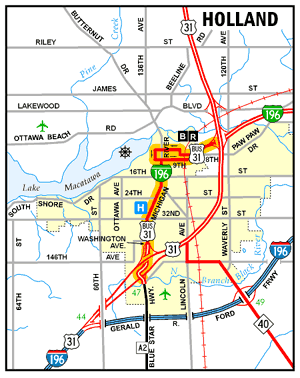Holland Business Routes: The Turnback
 Until
August 2004, the City
of Holland was home to two separate state trunkline Business Connections—BUS US-31 and BL
I-196—the former bringing traffic into downtown Holland from the US-31 bypass
since 1955 and the latter, somewhat newer, serving as a loop off I-196 since
1973. The former Business Connections through the city are highlighted on
the map at right.
Until
August 2004, the City
of Holland was home to two separate state trunkline Business Connections—BUS US-31 and BL
I-196—the former bringing traffic into downtown Holland from the US-31 bypass
since 1955 and the latter, somewhat newer, serving as a loop off I-196 since
1973. The former Business Connections through the city are highlighted on
the map at right.
In more recent times, however, an adversarial relationship has developed between the City of Holland and the Michigan Dept of Transportation (MDOT). The reasons for this falling out are numerous, but include a perceived lack of willingness to compromise on both sides, a differing view of how a downtown arterial should function, and even things as specific as the number of through travel lanes versus the average daily traffic volume.
The City of Holland had wanted to add additional parking spaces to its downtown core for several years, while MDOT maintained traffic volumes on the Business Routes through downtown exceeded the threshold for a two-lane street, thus taking what could be a lane of parking spaces for a third through traffic lane.
Beginning in the mid-1990s, the City of Holland began prompting MDOT to turn back the routes of BUS US-31 and BL I-196 through the city to local control so the City could implement its own parking configurations, speed limits, traffic signal timings and the like. In 2004, MDOT relented and began the process of transferring jurisdiction of the Business Routes through the city back to local control. In addition to the transfer itself, MDOT made a one-time payment of $3.5 Million dollars ($3,500,000.00) to the City of Holland as a part of the transfer process. The Holland City Council voted on August 4, 2004 to take back the route through the city, while the Ottawa County Road Commission took over the portion of Chicago Dr from 8th St to the US-31 interchange northeast of the city.
While the Road Commission promptly removed all state trunkline signage on their portion of the transferred business route, the City of Holland waited more than nine months to begin implementing signage changes on their portion. In May 2005, all BUS US-31 and BL I-196 route markers (save for one straggler at the Chicago Dr & 8th St intersection) were removed and a few of these assemblies were replaced with "TO US-31" trailblazer assemblies. However, since only a few of thse trailblazer assemblies were erected, motorists are not adequately directed through the city and are very likely to become lost or turned around while attempting to return to US-31. For example, westbound motorists on 8th St are directed to turn right onto Lincoln St with a "TO US-31" assembly, there is no such signage at the corner of 7th St & Pine Ave, nor is there signage on Pine Ave at 9th St. The unsuspecting motorist would simply have to "know" to make those two left turns before once again finding "TO US-31" signage on eastbound 9th St at River Ave.
In addition MDOT left signage directing motorists along northbound US-31 to the non-existant business route until sometime in 2006 when the signs at to thezhe Washington Ave/Blue Star Hwy interchange were modified to indicate "DOWNTOWN Holland" for the former business route and "US-31/BL I-196 - Muskegon" for through traffic. However, for six years, after passing the Washington Ave/Blue Star Hwy interchange all reassurance route markers indicated only US-31 and made no mention of BL I-196 until encountering the remainder of the route at the Chicago Dr interchange. The discontinuity for BL I-196, which then existed for 2.1 miles south of Holland and again for 5.3 miles east of Holland past Zeeland, remained until BL I-196 route markers were posted along US-31 in 2009-10.
It is the opinion of the author and several others that there will be many unintended side-effects to this transfer which could do more harm to the City of Holland and its efforts to maintain a bright, healthy, competitive and vibrant downtown shopping and dining district. With the tourism industry becoming an ever-increasing part of Holland's economy, ridding the city of three convenient, easy-to-follow tourist/visitor routes (two Business Routes and the Lake Michigan Circle Tour) seems contrary to what the City is attempting to provide: a welcoming community for visitors and tourists to spend time and, more importantly, their tourism dollar.
The author and several other interested individuals sent letters of concern to various civic leaders in Holland during July 2004 when the first concrete news of the jurisdictional transfer plans began to leak out. The mayor, city manager, Chamber of Commerce president, Downtown Development Authority director and local transportation planner all received communications. A presentation, linked below, was given at a local Rotary club meeting in mid-August to an interested group of local citizens.
- Retain Holland's Business Routes - presentation given at Holland AM Rotary, August 18, 2004. (PDF, 1.0 MB)
- Letter to Holland Mayor Al McGeehan - July 1, 2004
Additional Information
- Holland Business Route-related articles from the Holland Sentinel - 1998 through 2004.
- BUS US-31 Listing - in the listings section of this website.
- BL I-196 Listing - in the listings section of this website.

